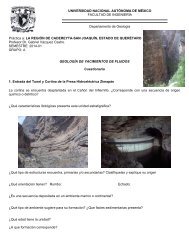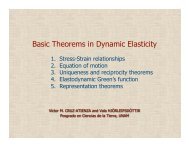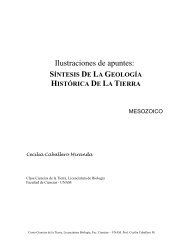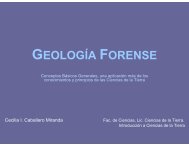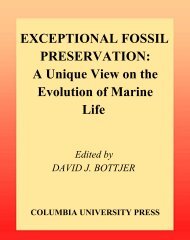Some features of the sources of relativistic particles at the Sun in the ...
Some features of the sources of relativistic particles at the Sun in the ...
Some features of the sources of relativistic particles at the Sun in the ...
- No tags were found...
Create successful ePaper yourself
Turn your PDF publications into a flip-book with our unique Google optimized e-Paper software.
416 E.V. Vashenyuk et al. / Advances <strong>in</strong> Space Research 38 (2006) 411–417non<strong>rel<strong>at</strong>ivistic</strong> energy doma<strong>in</strong> (Ellison and Ram<strong>at</strong>y,1985). Be<strong>in</strong>g based on our earlier results, we are more<strong>in</strong>cl<strong>in</strong>ed to consider acceler<strong>at</strong>ion by MHD turbulenceas a probable mechanism for DC form<strong>at</strong>ion dur<strong>in</strong>gexplosive energy release <strong>in</strong> a flare (Miroshnichenko etal., 1996). The proton spectrum <strong>in</strong> such a case has avariable slope and should be described by a curve suchas Bessel functions <strong>in</strong> rigidity <strong>in</strong> general case and by<strong>the</strong> power law <strong>in</strong> <strong>the</strong> high-energy limits (Gallegos-Cruzand Perez-Peraza, 1995). Our experimentally obta<strong>in</strong>edspectra <strong>of</strong> DC <strong>of</strong> <strong>rel<strong>at</strong>ivistic</strong> solar protons obviouslycorrespond to this <strong>the</strong>oretical result. Therefore, consider<strong>in</strong>g<strong>the</strong> tim<strong>in</strong>g <strong>of</strong> gener<strong>at</strong>ion and release <strong>of</strong> two <strong>rel<strong>at</strong>ivistic</strong>proton components: PC and DC from <strong>the</strong> solarcorona, a follow<strong>in</strong>g scenario may be suggested. Theprompt component <strong>of</strong> RSP is produced dur<strong>in</strong>g <strong>in</strong>itialenergy release <strong>in</strong> a low-coronal magnetic null po<strong>in</strong>t.This process is l<strong>in</strong>ked with <strong>the</strong> H-alpha eruption, onset<strong>of</strong> CME and type II radio emission. The acceler<strong>at</strong>ed<strong>particles</strong> <strong>of</strong> PC leave <strong>the</strong> corona along open field l<strong>in</strong>eswith diverg<strong>in</strong>g geometry th<strong>at</strong> results <strong>in</strong> high anisotropydue to strong focus<strong>in</strong>g <strong>of</strong> a particle bunch. The DC<strong>particles</strong> are trapped orig<strong>in</strong>ally <strong>in</strong> magnetic arches <strong>in</strong><strong>the</strong> low corona. As <strong>the</strong> disturbance grows, DC <strong>particles</strong>are acceler<strong>at</strong>ed by a stochastic mechanism <strong>at</strong> <strong>the</strong> MHDturbulence <strong>in</strong> expand<strong>in</strong>g flare plasma. Acceler<strong>at</strong>ed <strong>particles</strong>can be <strong>the</strong>n carried out to <strong>the</strong> outer corona by anexpand<strong>in</strong>g (lift<strong>in</strong>g) CME. They are released <strong>in</strong>to <strong>in</strong>terplanetaryspace after <strong>the</strong> magnetic trap is destroyedgiv<strong>in</strong>g rise to an extended <strong>in</strong> time and azimuth <strong>particles</strong>ource.AcknowledgementsAuthors are gr<strong>at</strong>eful to all researches presented <strong>the</strong>d<strong>at</strong>a <strong>of</strong> neutron monitors used <strong>in</strong> this study. Neutronmonitors <strong>of</strong> <strong>the</strong> Bartol Research Institute are supportedby NSF Grant ATM-0000315, <strong>the</strong> d<strong>at</strong>a were providedby R. Pyle, especial thanks we express to V.G. Yankeand E.A. Eroshenko, IZMIRAN, Moscow, M. Stor<strong>in</strong>i,Istituto di Fisica dello Spazio Interplanetario, Roma,P. Stoker, North-West University Potchefstroom, SouthAfrica, P. Lantos, French Polar Institute and Paris-Meudon Observ<strong>at</strong>ory, The Russian neutron monitornetwork was supported by GK Grant 10002-251/P-06/048-051/200404-046, Russian Found<strong>at</strong>ion <strong>of</strong> Basic Research(RFBR) Projects 04-02-16763, 03-07-90389.This work was supported <strong>in</strong> part by <strong>the</strong> RFBR Projects02-02-16987, 02-02-39032, 03-02-96026, 05-02-17143.The work <strong>of</strong> L.I.M. is also supported by <strong>the</strong> FederalPurpose Scientific and Technical Program (Section I,Project 4), and PresidentÕs Grant <strong>of</strong> Russian Feder<strong>at</strong>ion(Project SS-1445.2003.2).ReferencesBazilevskaya, G.A., Svirzhevskaya, A.K. On <strong>the</strong> str<strong>at</strong>ospheric measurements<strong>of</strong> cosmic rays. Space Sci. Rev. 85, 431–521, 1998.Bieber, J.W., M<strong>at</strong>thaeus, W.H., Smith, C.W., Wanner, W., Kallenrode,M.-B., Wibberenz, G. Proton and electron mean free p<strong>at</strong>h:The Palmer consensus revisited. Astrophys. J. 420, 294–306, 1994.Bieber, J.W., Droge, W., Evenson, P.A., Pyle, R., Ruffolo, D.,P<strong>in</strong>sook, U., Tooprakai, P., Rujiwarodom, M., Khumlumlert, T.,Krucker, S. Energetic particle observ<strong>at</strong>ions dur<strong>in</strong>g <strong>the</strong> 2000 July 14solar event. Astrophys. J. 567, 622–634, 2002.Bulanov, S.V., Sasorov, P.V. Energetic spectrum <strong>of</strong> <strong>particles</strong> acceler<strong>at</strong>ed<strong>in</strong> <strong>the</strong> neighbourhood <strong>of</strong> zero l<strong>in</strong>e <strong>of</strong> <strong>the</strong> magnetic field.Astron. J. 52 (4), 763–771, 1975.Cliver, E.W., Kahler, S.W., Shea, M.A., Smart, D.F. Injection onsets<strong>of</strong> 2 GeV protons and 1 MeV electrons and 100 keV electrons<strong>in</strong> solar cosmic ray flares. Astrophys. J. 260, 362–370, 1982.Cramp, J.L., Duldig, M.L., Humble, J.E. The effect <strong>of</strong> a distorted<strong>in</strong>terplanetary magnetic field configur<strong>at</strong>ion on <strong>the</strong> December 7–8,1982, ground level enhancement. J. Geophys. Res 102 (A3), 4919–4925, 1997a.Cramp, L.J., Duldig, M.L., Flueckiger, E.O., Humble, J.E., Shea,M.A., Smart, D.F. The October 22, 1989, solar cosmic rayenhancement: an analysis <strong>of</strong> <strong>the</strong> anisotropy and spectral characteristics.J. Geophys. Res. 102 (A11), 24237–24248, 1997b.Debrunner, H., Flueckiger, E., Gradel, H., Lockwood, J.A., McGuire,R.E. Observ<strong>at</strong>ions rel<strong>at</strong>ed to <strong>the</strong> acceler<strong>at</strong>ion, <strong>in</strong>jection, and<strong>in</strong>terplanetary propag<strong>at</strong>ion <strong>of</strong> energetic protons dur<strong>in</strong>g <strong>the</strong> solarcosmic ray event on February 16, 1984. J. Geophys. Res. 93 (A7),7206–7216, 1988.Duldig, M. F<strong>in</strong>e time resolution analysis <strong>of</strong> <strong>the</strong> 14 July 2000 GLE.Proc. 27th Int. Cosmic Ray Conf. 3, 3417–3420, 2001.Ellison, D.C., Ram<strong>at</strong>y, R. Shock acceler<strong>at</strong>ion <strong>of</strong> electrons and ions <strong>in</strong>solar flares. Astrophys. J. 298, 400–408, 1985.Gallegos-Cruz, A., Perez-Peraza, J. Deriv<strong>at</strong>ion <strong>of</strong> analytical <strong>particles</strong>pectra from <strong>the</strong> solution <strong>of</strong> <strong>the</strong> transport equ<strong>at</strong>ion by <strong>the</strong> WKBJmethod. Astrophys. J. 446, 400–420, 1995.Kahler, S. Injection pr<strong>of</strong>iles <strong>of</strong> solar energetic <strong>particles</strong> as functions <strong>of</strong>coronal mass ejection heights. Astrophys. J. 428, 837–842, 1994.Kle<strong>in</strong>, K.-L., Trottet, G., Lantos, P., Delaboud<strong>in</strong>iere, J.-P. Coronalelectron acceler<strong>at</strong>ion and <strong>rel<strong>at</strong>ivistic</strong> proton production dur<strong>in</strong>g <strong>the</strong> 14July 2000 flare and CME. Astron. Astrophys. 373, 1073–1082, 2001.Miroshnichenko, L.I. Solar cosmic rays. Kluwer Academic Publishers,Dordrecht, 2001, p. 492.Miroshnichenko, L.I., Perez-Peraza, J., Vashenyuk, E.V., Rodriguez-Frias, M.D., del Peral, L., Gallegos-Cruz, A. On <strong>the</strong> form<strong>at</strong>ion <strong>of</strong><strong>rel<strong>at</strong>ivistic</strong> particle fluxes <strong>in</strong> extended coronal structures. <strong>in</strong>:Ram<strong>at</strong>y, R., Mandzhavidze, N., Hua, X.-M. (Eds.), High energysolar physics. AIP Press, New York, pp. 140–149, 1996.Manoharan, P.K., Kundu, M.R. Coronal structure <strong>of</strong> a flar<strong>in</strong>g regionand associ<strong>at</strong>ed coronal mass ejection. Astrophys. J. 592, 597–606,2003.Pchelk<strong>in</strong>, V.V., Vashenyuk, E.V., Ostapenko, A.A., Maltsev, Yu.P.Rel<strong>at</strong>ivistic SCR <strong>in</strong> <strong>the</strong> event <strong>of</strong> 7–8 December 1982. Impact <strong>of</strong>magnetospheric disturbance <strong>at</strong> <strong>the</strong> analysis <strong>of</strong> ground-based<strong>in</strong>crease. Geomagnet. Aeronom. 40 (5), 39–44, 2000 (<strong>in</strong> Russian).Perez-Peraza, J., Gallegos-Cruz, A., Vashenyuk, E.V., Miroshnichenko,L.I. Spectrum <strong>of</strong> acceler<strong>at</strong>ed <strong>particles</strong> <strong>in</strong> solar protonevents with a prompt component. Geomagnet. Aeronom. 32 (N2),1–10, 1992.Perez-Peraza, J., Galegos-Cruz, A., Vashenyuk, E.V., Miroshnichenko,L.I. Efficiency for RSP acceler<strong>at</strong>ion <strong>in</strong> <strong>the</strong> 14.07.2000 and 15.04.2001events. Proc. 28th Int. Cosmic Ray Conf. 6, 3327–3330, 2003.Shea, M.A., Smart, D.F. Possible evidence for a rigidity-dependentrelease <strong>of</strong> <strong>rel<strong>at</strong>ivistic</strong> protons from <strong>the</strong> solar corona. Space Sci. Rev.32, 251–271, 1982.



